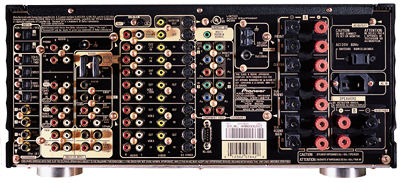Pioneer Elite VSX-49TX A/V receiver Page 2
[Graphic equalizers can be helpful in performing broad corrections, but are very limited in their ability to cure narrow band problems, particularly in the bass. So it's perhaps significant that the Pioneer's equalizer operates on the main channels only, not the subwoofer. Equalization is a complex and (except in the bass) controversial subject. We recommend that you listen to the receiver with no equalization for at least part of any audition. Also, new owners might be well advised to live with the receiver without equalization for a few weeks. Only then, if you feel that changes are needed, should you experiment. Start with small corrections. The Pioneer provides an EQ Gain Over warning indication to signal too heavy a hand on the EQ controls; take it seriously. Avoid any tendency to use excessive boost in any band—whether you set the equalization manually or automatically—as it can drive a system into distortion.—TJN]

I won't describe the onscreen display's (OSD) setup menu system for assigning digital inputs, video outputs, and sonic preferences for each channel, because they're all easily accomplished. What a pleasure to have all this adjustability available and actually usable without fear of ending up with the No-Sound Syndrome. First-time users of home-theater receivers should be able to get the VSX-49TX to do their bidding without anxiety attacks, pulling out their hair, or angry phone calls to the dealer. In fact, even if the Elite dealer offers to do it free of charge, I recommend that you set this baby up yourself. Along with a sense of accomplishment, you'll end up knowing your way around the system in a way you never could if you were simply handed a remote and shown which buttons to push.
Listening
But what good are a pleasant setup procedure and easy use and access if the sound doesn't match? The Pioneer Elite VSX-49TX lived up to its billing. It delivered all the clean power one could ask from its high-powered amplifiers, but, more important, it did so with the smoothness and effortless control you rarely get from a receiver, though many top-shelf units are comparable if not quite as accomplished. I felt it important to run the system unequalized for most of my listening, since no other receiver I've auditioned in my room has enjoyed the benefit of EQ. I did a considerable amount of listening in the EQ'd mode as well, however, and in my system the equalized response was definitely an improvement.
Some receivers lack transparency, and sound thin in the midrange or seem to add an edgy or hashy overlay to the high frequencies. With or without EQ, the VSX-49TX had a rich, coherent overall balance that didn't draw attention to any particular frequency range. It had the balls of the B&K 307 and the transparency and delicacy of the Denon AVR-5800, which are among the best-sounding receivers I've heard. But the Pioneer also had an enveloping 3-dimensional lushness (even in 2-channel mode) that neither of those had, plus, overall, the least mechanical sound I've yet heard from a receiver. Like a good tube amp, it positively bloomed.
Beyond frequency response, the VSX-49TX delivered the rhythmic drive, bass control, and harmonic integrity one usually associates with separates. On multichannel audio discs like DTS's new 24/96, 5.1-channel edition of Queen's A Night at the Opera, the receiver rocked my room at absurdly high SPLs without becoming hard, etched, or stressed, and the coherence of the 5.1-channel picture created a sense of wholeness instead of five monophonic mixes competing for my attention. I've probably used those same words in other reviews; the Pioneer set a new standard in this regard.
Particularly impressive were the purity, speed, and smoothness of vocal sibilants. I haven't heard A Night at the Opera on other receivers, so I can't say how much was the expertise of the mix engineer and how much was the receiver. But if you want to put your system through its paces and have some audio fun, get this disc, if only for the pyrotechnics of "Bohemian Rhapsody." Rock on, Garth!
There are two multichannel analog input options. One is direct, so the analog is fed through to the outputs unchanged—the preferred mode for SACD, and one in which each channel goes through a high-quality A/D conversion. That mode allows you to adjust individual channel levels and use other sound-tailoring and bass-management functions. Incidentally, it makes sense to get a bundled six-cable interconnect for your DVD-Audio or SACD multichannel analog connection, instead of mixing whatever cables you may have lying around. I went from just that sort of motley assortment to a nicely terminated, reasonably priced six-cable Harmonic Technology bundle, and it really cleaned up the sound.
For another kind of sonic depth charge, I slipped The Film Music of Jerry Goldsmith (Telarc SACD-60433) into the Sony XA-777ES SACD player. Recorded at Abbey Road, this multichannel recording includes selections from Goldsmith's soundtrack scores for Star Trek: The Motion Picture, The Sand Pebbles, Chinatown, Air Force One, Poltergeist, a medley of his TV themes (The Man from U.N.C.L.E., Dr. Kildare, The Waltons, etc.), and seven other Goldsmith gems. The VSX-49TX revealed the disc's rich, detailed midrange performance, its ability to deliver accomplished string tones, and its overall sophisticated tonal and harmonic palettes. The unforgettably lonely, melancholy trumpet stating the theme to Chinatown, backed by sweeping strings, could make a multichannel believer of the most diehard 2-channel enthusiast. Bass extension, dynamics, and control were spectacular at one end, while air and ambience on top added an enveloping cushion to what was about the most satisfying musical experience I've had in my home-theater system.





























































